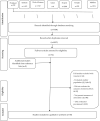Physical activity and quality of life among college students without comorbidities for cardiometabolic diseases: systematic review and meta-analysis
- PMID: 34800221
- PMCID: PMC8605778
- DOI: 10.1007/s11136-021-03035-5
Physical activity and quality of life among college students without comorbidities for cardiometabolic diseases: systematic review and meta-analysis
Abstract
Purpose: To systematically review studies on the relationship between physical activity (PA) and quality of life (QOL) in university students without comorbidities for cardiometabolic diseases from around the world.
Methods: We included observational studies with university students of both sexes, from public or private institutions, and that investigated the association or correlation between physical activity and quality of life among these students, without delimitation of date, language, or location. Reviews, letters to the editors, studies with qualitative methodologies, case studies, book chapters, articles with college students who had some specific disease or condition, such as obesity, diabetes, and others; studies with children of parents with chronic diseases, and those that were institutions aimed only at very specific populations, were excluded. Meta-analysis was calculated.
Results: Thirty studies, consisting of 19,731 students, were included. The most commonly used instruments to assess the quality of life of the university population were the Quality of Life Questionnaire-short version (WHOQOL-BREF), and the Medical Outcomes Study 36-Item Short-Form Health Survey (SF-36). The International Physical Activity Questionnaire (IPAQ) was the most commonly used instrument to assess PA. For the meta-analysis, 22 studies were included. Weak but positive correlations were found between PA and the QOL domains: physical health (0.16. 95% CI 0.11 0.22; I2 = 99.96%); mental health (0.14; 95% CI 0.07-0.20; I2 = 99.97%); social relations (0.24, 95% CI 0.08-0. 38; I2 = 99.99%); environment (0.23, 95% CI 0.14-0.32; I2 = 99.90%); vitality (0.17. 95% CI 0.15-0.20; I2 = 99.49%) pain (0.02. 95% CI - 0.02 to 0.12; I2 = 99.96%); QOL and PA (0.21, 95% CI 0.08-0.34; I2 = 99.99%).An association of R = 0.60 (95% CI 0.25-0.95; I2 = 85.61%) was found between QOL and PA in total.
Conclusion: The results of our study showed a weak but positive relationship between physical activity and overall quality of life in college students, and also between PA and the domains of QL: physical health, social relationships, mental health, environment, and vitality, in this same population. It is important to study this population, since risk behaviors in this phase tend to perpetuate in the other phases of life.
Keywords: Higher education; Meta-analysis; Physical activity; Quality of life; Systematic review; University students.
© 2021. The Author(s), under exclusive licence to Springer Nature Switzerland AG.
Conflict of interest statement
There is no conflict of interest regarding the research, authorship, or publication of this article.
Figures










References
-
- García Hermoso A, et al. Reallocating sedentary time to moderate to vigorous physical activity but not to light intensity physical activity is effective to reduce adiposity among youths: a systematic review and meta- analysis. Obesity Reviews. 2017;18(9):1088–1095. doi: 10.1111/obr.12552. - DOI - PubMed
-
- World Health Organization (2014). Global status report on noncommunicable diseases. Disponível em: https://apps.who.int/iris/bitstream/handle/10665/148114/9789241564854_en....
Publication types
MeSH terms
LinkOut - more resources
Full Text Sources

